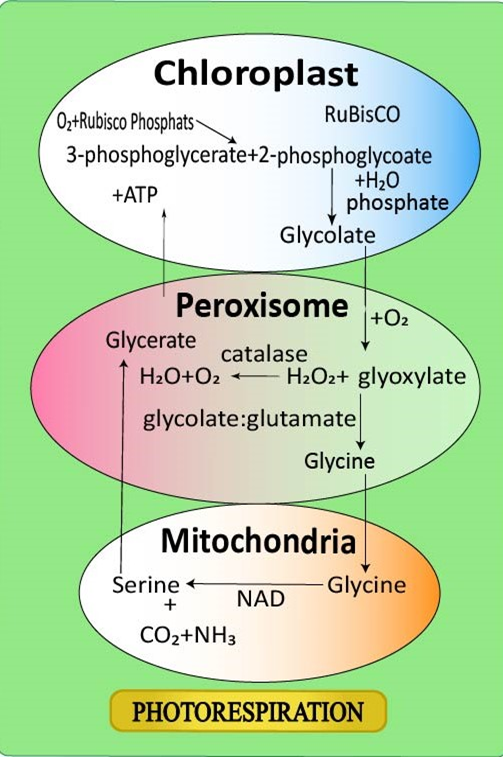
Photorespiration takes place in
(a)Chloroplast, mitochondria
(b)Mitochondria, peroxisome
(c)Chloroplasts, peroxisome, mitochondria
(d)Chloroplast, cytoplasm, mitochondria
Answer
584.7k+ views
Hint: Photorespiration is a process in plant metabolism where enzyme RuBisCO oxygenates RuBP. This reaction takes place in three organelles of plants. It is a wasteful process that occurs in ${ C }_{ 3 }$ plants that inhibit the rate of photosynthesis in the existence of high oxygen concentration in light.
Complete answer:
The ${ C }_{ 3 }$ plants start releasing carbon dioxide in light during an extra input of oxygen in the presence of a high concentration of oxygen. Photorespiration is an enzymatic process that takes place in three organelles in plants namely: chloroplasts, mitochondria, and peroxisomes and involves specialized reactions.
The enzyme Rubisco (RuBisCO Ribulose-1,5-bisphosphate carboxylase/oxygenase) acts as an oxygenase and is used for the fixation of carbon dioxide through the Calvin cycle. In the presence of low carbon dioxide concentration it splits a molecule of RuBP (Ribulose 1,5-bisphosphate) into 2-phosphoglycolic acid and 3- phosphoglyceric acid.
The high concentration of oxygen allows the oxygenation of Rubisco as the Calvin cycle hinders. This leads to the formation of 2-phosphoglycolic acid which is metabolized by the process of photorespiration into phosphoglyceric acid (PGA) which advances and enters the Calvin cycle. In the photorespiratory process, there is neither synthesis of sugars, ATP nor of NADPH, and releases carbon dioxide with the utilization of ATP.

So, the correct answer is ‘chloroplast, peroxisomes, and mitochondria’.
Note: Electrons and protons play a crucial role during the light reaction. When sunlight is absorbed by the
photo-pigments, the absorbed light energy is used in the photolysis of water and to drive electrons to generate NADPH. The same light energy is used to drive protons across a membrane and when these protons return the ATP molecule is synthesized.
Complete answer:
The ${ C }_{ 3 }$ plants start releasing carbon dioxide in light during an extra input of oxygen in the presence of a high concentration of oxygen. Photorespiration is an enzymatic process that takes place in three organelles in plants namely: chloroplasts, mitochondria, and peroxisomes and involves specialized reactions.
The enzyme Rubisco (RuBisCO Ribulose-1,5-bisphosphate carboxylase/oxygenase) acts as an oxygenase and is used for the fixation of carbon dioxide through the Calvin cycle. In the presence of low carbon dioxide concentration it splits a molecule of RuBP (Ribulose 1,5-bisphosphate) into 2-phosphoglycolic acid and 3- phosphoglyceric acid.
The high concentration of oxygen allows the oxygenation of Rubisco as the Calvin cycle hinders. This leads to the formation of 2-phosphoglycolic acid which is metabolized by the process of photorespiration into phosphoglyceric acid (PGA) which advances and enters the Calvin cycle. In the photorespiratory process, there is neither synthesis of sugars, ATP nor of NADPH, and releases carbon dioxide with the utilization of ATP.

So, the correct answer is ‘chloroplast, peroxisomes, and mitochondria’.
Note: Electrons and protons play a crucial role during the light reaction. When sunlight is absorbed by the
photo-pigments, the absorbed light energy is used in the photolysis of water and to drive electrons to generate NADPH. The same light energy is used to drive protons across a membrane and when these protons return the ATP molecule is synthesized.
Recently Updated Pages
The number of solutions in x in 02pi for which sqrt class 12 maths CBSE

Write any two methods of preparation of phenol Give class 12 chemistry CBSE

Differentiate between action potential and resting class 12 biology CBSE

Two plane mirrors arranged at right angles to each class 12 physics CBSE

Which of the following molecules is are chiral A I class 12 chemistry CBSE

Name different types of neurons and give one function class 12 biology CBSE

Trending doubts
One Metric ton is equal to kg A 10000 B 1000 C 100 class 11 physics CBSE

Explain zero factorial class 11 maths CBSE

What is 1s 2s 2p 3s 3p class 11 chemistry CBSE

Discuss the various forms of bacteria class 11 biology CBSE

State the laws of reflection of light

An example of chemosynthetic bacteria is A E coli B class 11 biology CBSE




